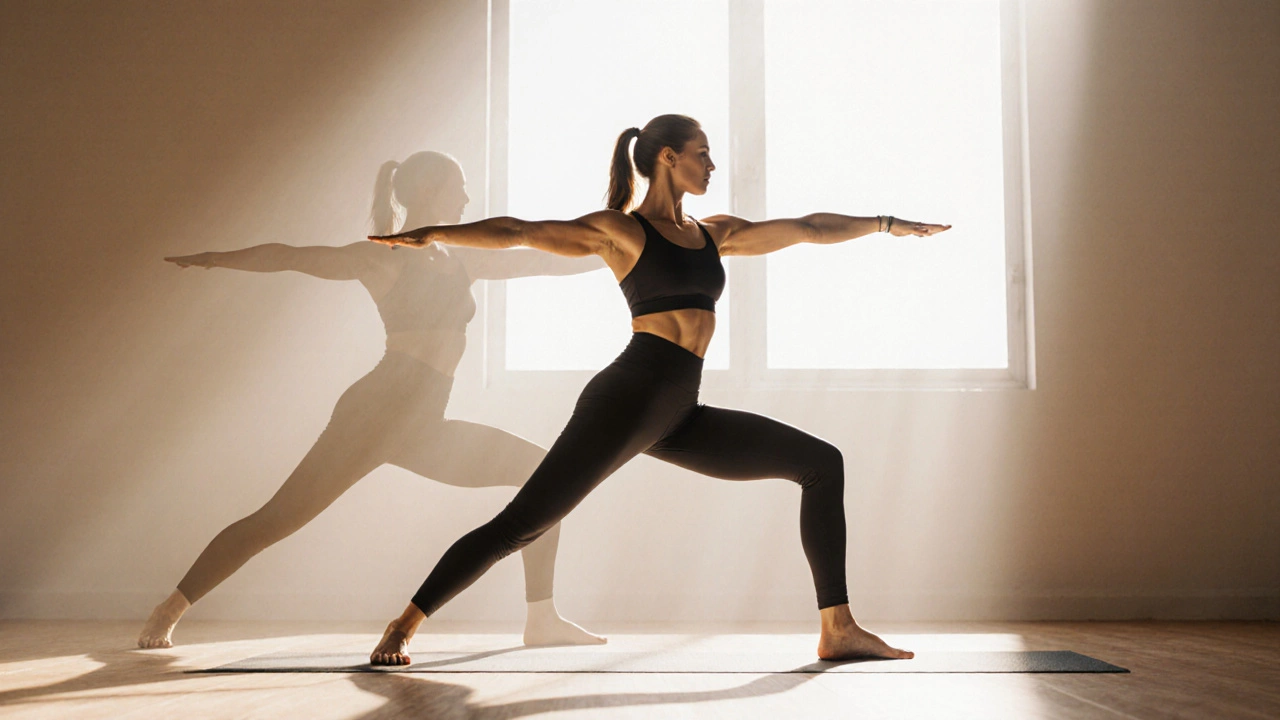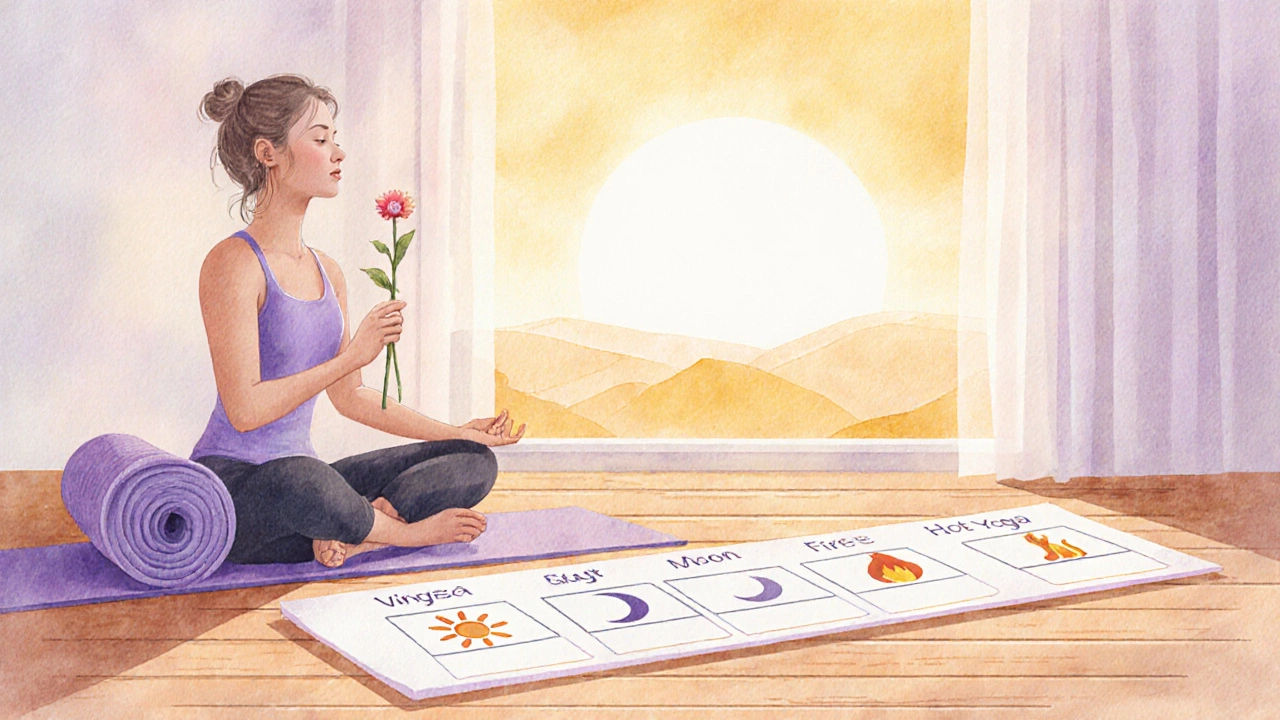
Yoga Body Transformation Tracker
Start Your Tracking
Enter your starting measurements to monitor your yoga body transformation journey
Ever wonder if yoga body shape changes are real or just hype? You’ve probably seen sleek Instagram feeds, heard friends brag about a flatter tummy after a few months of practice, and now you’re asking: will yoga actually reshape me? The short answer is yes-Yoga can shift the way you look, but the results depend on the style, frequency, and how you pair it with diet and lifestyle.
How Yoga Impacts Body Composition
Yoga isn’t just about flexibility; it’s a full‑body workout that influences body composition-the ratio of lean muscle to fat. When you move through a flow, you’re engaging multiple muscle groups, boosting heart rate, and stimulating metabolic pathways. Over time, those repeated micro‑contractions build muscle tone while helping the body mobilize stored fat for energy.
The key mechanisms are:
- Calorie burn: A vigorous Vinyasa class can torch 300‑500 calories per hour, comparable to moderate‑intensity cardio.
- Hormonal balance: Yoga lowers cortisol, a stress hormone that encourages abdominal fat storage.
- Improved insulin sensitivity: Consistent practice helps muscles use glucose more efficiently, reducing the likelihood of excess fat.
All of these factors gradually shift your silhouette-waistline tightens, hips become more defined, and shoulders gain subtle definition.
Muscle Tone vs Fat Loss: What Yoga Actually Does
Many people equate “getting skinny” with losing weight, but yoga’s biggest visual impact comes from muscle tone. Toned muscles hold their shape better than flabby tissue, so even if the scale barely moves, you’ll notice a firmer, more sculpted look.
Contrast this with pure cardio, which primarily burns calories without building much muscle. Strength training, on the other hand, maximizes muscle mass but can leave you feeling stiff if flexibility isn’t addressed. Yoga blends both worlds, giving you a lean‑muscle appearance while preserving joint health.
For example, a 12‑week study of beginner yoga participants showed a 2.5% reduction in body fat and a 4% increase in lean mass, while a control group doing only treadmill walking saw no change in lean mass.
Comparing Yoga to Other Workouts
If you’re trying to decide whether to add yoga to your routine, a side‑by‑side look helps. Below is a quick comparison of how three popular exercise types influence body shape.
| Aspect | Yoga | Cardio (e.g., running, cycling) | Strength Training |
|---|---|---|---|
| Calorie Burn (per hour) | 300‑500 | 400‑700 | 200‑350 |
| Muscle Tone | Moderate‑high (full‑body) | Low‑moderate | High (targeted) |
| Flexibility | High | Low‑moderate | Low |
| Cortisol Reduction | Significant | Minimal | Variable |
| Joint Stress | Low | Medium‑high (impact dependent) | Medium (depends on load) |
Yoga sits nicely in the middle: it burns enough calories to aid fat loss, builds functional muscle, and adds flexibility that keeps you moving safely.

Types of Yoga Most Effective for Shaping
Not all yoga styles deliver the same body‑shaping benefits. Here’s a quick rundown of the most sculpt‑focused practices:
- Vinyasa / Power Yoga: Fast‑paced, flow‑based sequences keep heart rate up and engage core, arms, and legs continuously.
- Ashtanga: Fixed series of poses that repeat daily; excellent for building endurance and strength.
- Hot Yoga (Bikram): Heat increases sweat loss and heart rate, upping calorie burn while encouraging deeper tissue work.
- Hatha (Strength‑Focused): Slower but includes plenty of body‑weight holds (e.g., Chair Pose, Warrior III) that target large muscle groups.
If shaping is your primary goal, aim for at least three 60‑minute Vinyasa or Ashtanga sessions per week, complemented by a gentle Hatha class for recovery.
Common Myths About Yoga and Body Shape
Myth #1: “Yoga won’t build muscle.” Wrong. Holding poses like Plank or Chaturanga engages the same muscle fibers as push‑ups.
Myth #2: “You have to be thin to do yoga.” Yoga adapts to every body type. Modifications let beginners protect joints while still activating muscles.
Myth #3: “Only the core changes.” While the core is a hotspot, the shoulders, glutes, and hamstrings also see noticeable toning when you practice balanced sequences.

Practical Routine to Shape Your Body
Below is a 4‑week starter plan that blends calorie burn, strength, and flexibility.
- Monday - Vinyasa Flow (60 min)
- Sun Salutations x5 (warm‑up)
- Warrior II → Reverse Warrior → Side Angle (3 rounds each side)
- Plank → Chaturanga → Upward Dog → Downward Dog (repeat 5 times)
- Boat Pose hold 30 sec ×3 (core)
- Tuesday - Rest or gentle Hatha (30 min)
Focus on deep stretches for hips and hamstrings to aid recovery.
- Wednesday - Power Yoga (45 min)
- High‑intensity flow with jump‑backs and crow pose
- Finish with Bridge Pose holds (glutes)
- Thursday - Active recovery (walk or light bike, 30 min)
- Friday - Ashtanga Primary Series (75 min)
- Five‑point pose, standing sequence, seated sequence, backbends
- Saturday - Hot Yoga (90 min)
Stick to the studio’s preset flow; the heat amplifies calorie burn.
- Sunday - Rest
Progressively increase hold times by 5‑10 seconds each week and add a second round of the flow after month one.
Tracking Progress and Adjustments
Scale weight isn’t the best metric for shape changes. Try these:
- Body measurements: waist, hips, thigh, and arm circumference every two weeks.
- Progress photos: front, side, and back at consistent lighting.
- Flexibility tests: reach‑forward sit‑and‑reach, deep squat depth.
- Strength markers: ability to hold Plank for 2 minutes or perform 10 full‑range crow poses.
If you plateau after six weeks, add a short HIIT circuit (e.g., 30 seconds burpees, 30 seconds rest ×10) after the yoga session to spike calorie burn.
Frequently Asked Questions
Can yoga alone slim my waist?
Yes, especially when you practice styles that keep the heart rate up (Vinyasa, Power Yoga) and focus on core‑engaging poses. Pair it with a balanced diet and you’ll see a tighter waist within 8‑12 weeks.
Do I need equipment for yoga to change my shape?
No. A yoga mat is enough. Body weight acts as resistance. If you want extra challenge, use blocks or a strap, but they’re optional.
How many days a week should I practice?
Three to five sessions of 45‑60 minutes each give the best balance of calorie burn and recovery.
Will yoga make my arms look more defined?
Yes. Poses like Chaturanga, Dolphin, and Crow target the triceps, shoulders, and forearms, building lean muscle over time.
Is it safe to do yoga every day?
Daily light practice (20‑30 min) is fine, but intense flows need at least one rest or active‑recovery day to avoid overuse injuries.
